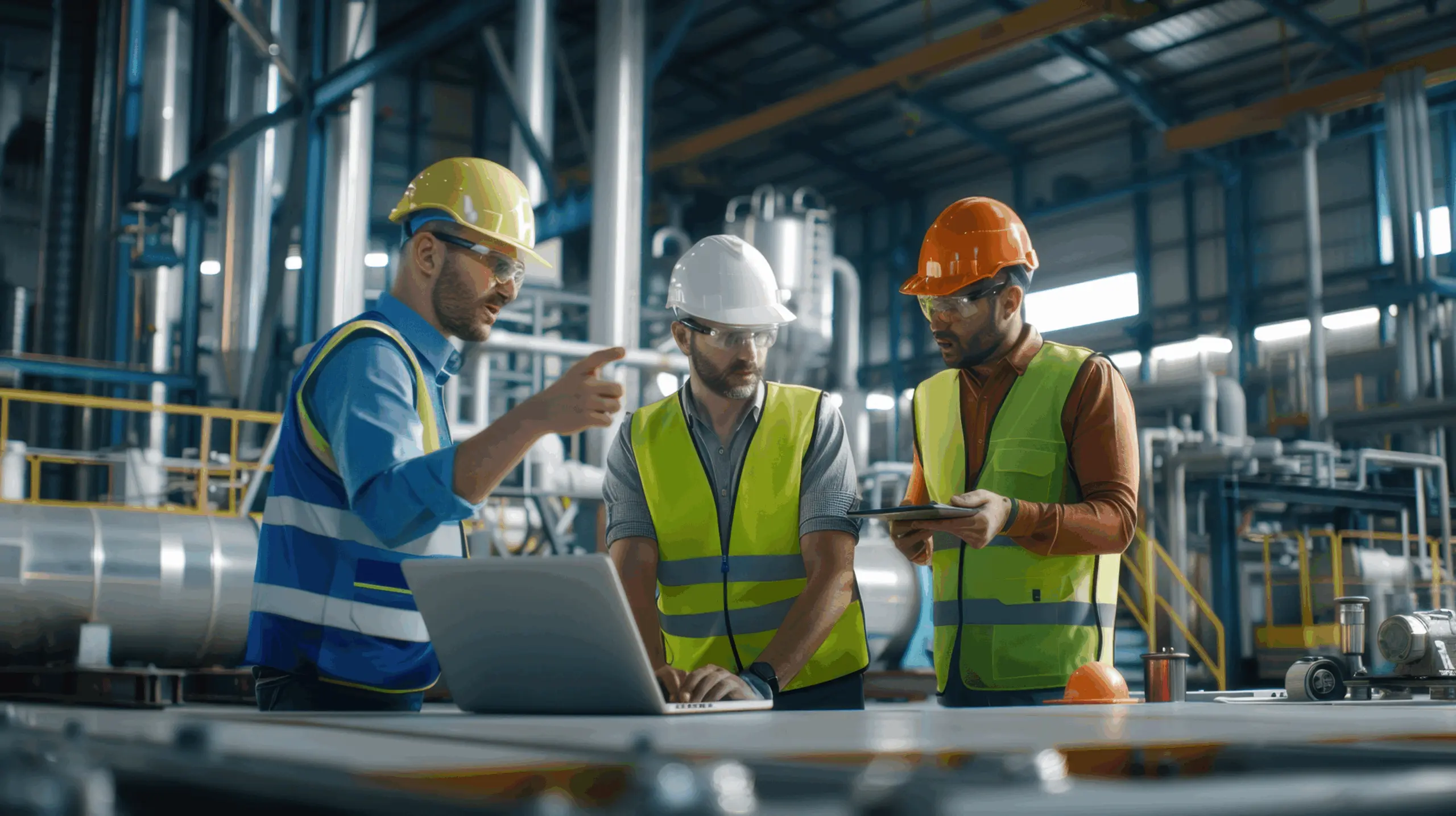How leadership transformation drives long-term success in engineering

Related content

Promoting safety in transportation through cultural transformation
Client need
Safety in the transportation industry has often been treated as a set of rules to follow and boxes to check. But one Spanish railway organization saw an opportunity to redefine safety as something far greater, a core value embedded into the culture of their company at every level.
This bold vision demanded more than compliance. It required a cultural transformation to challenge outdated behaviors, inspire teams, and empower leaders to embrace and model a safety-first mindset. For years, the organization had been working to foster a culture that prioritized protection over profit, setting new behavioral standards across the industry.
To accelerate this shift, the organization partnered with BTS to design a leadership development program that dismantled old practices and equipped leaders with the tools, insights, and behaviors needed to bring their vision to life.
- Deconstruct existing mindsets to enable cohesive change.
- Identify barriers preventing progress.
- Equip leaders with practical behavioral knowledge and tools.
Solution
BTS partnered with the organization to design a leadership journey that would reshape not just processes but perspectives, fostering a workplace where physical and psychological safety were paramount. Over eight months, the project team conducted interviews with leaders and focus groups to uncover critical behavioral insights and tailor the program to the organization’s unique needs.
Participants explored essential themes, including:
- Embedding safety into daily decision-making.
- Cultivating greater awareness of safety risks.
- Understanding the influence of their leadership on safety outcomes.
- Leading by example to set a cultural standard.
- Building trust, commitment, and open communication within their teams.
The program unfolded in three distinct phases to drive lasting behavioral change:
- Workshop preparation
Participants began with a self-assessment to uncover personal “safety blind spots” and mind traps. This phase, delivered through a custom online platform, helped leaders reflect on their current practices and prepare for the transformational journey ahead.
- Safety workshop
The one-day, immersive workshop was designed to spark deep conversations about safety culture, challenge ingrained mindsets, and equip participants with actionable strategies for change. Leaders engaged in real-world scenarios to explore the implications of their decisions and practice new behaviors. The day concluded with collaborative debrief sessions, leaving participants with practical tools to implement their insights immediately. - Implementation in action
To sustain momentum, the post-workshop phase extended over six months, offering six targeted activities. These activities reinforced key lessons, encouraged team collaboration, and provided ongoing support for integrating safety-first behaviors into daily routines.
The leadership program was delivered to 1500 participants over 66 workshops in seven locations across Spain.
Results
To measure results, the project team created a resource map evaluating progress.
Average completion rate of Activities One–Three: 57 percent. (One: 78.21%; Two: 53. 01%; Three: 40.57%)
A post-workshop survey was sent to participants, reporting on the following metrics:
- Average satisfaction — 4.7/5.
- Trainer’s evaluation — 4.9/5.
- NPS — 82 percent.
- “Saw improvement in safety alignment” — 93 percent.
- “Integrated safety tools in daily roles” — 82 percent.
- “Identified new initiatives for improving safety” — 77 percent.
- “Mitigated team/peer mind traps” — 93 percent.
- “More aware of risk in daily roles” — 98 percent.
- “Identified a normalized risk to work on” — 92 percent.
Testimonials
- “Many of the methodologies and tools not only help to improve safety but can also be used to improve operational or organizational processes.”
- “It has put us in front of the mirror of how we are today in terms of safety culture, opening our eyes to our development areas. Very participative and practical.”

Strengthening talent and leadership development in the aluminum industry
Client need
A leading global aluminum manufacturer faced a pivotal challenge: how to create a unified, empowered workforce in a highly decentralized organization. Each business unit operated autonomously, making it difficult to align global learning with local needs. The company recognized the need for enterprise-wide development programs that supported its business and HR strategies while preserving local flexibility.To meet this challenge, the organization launched a Corporate Learning University—a multi-year initiative to transform its approach to employee development. BTS collaborated with HR and L&D leaders to co-create a comprehensive portfolio of programs tailored to different roles and career stages across the enterprise.SolutionThe transformation began with a clear vision: align learning with strategic outcomes to unify and empower a decentralized workforce. BTS worked with the company to create an impact map linking business priorities—financial performance, safety, and employee engagement—to the behaviors and skills required at each level of the organization.The map established three key learning objectives:Foster unity and collaboration across a decentralized structure.Strengthen business acumen to improve contribution and decision-making.Build a shared leadership identity aligned with company values.Using these objectives as a foundation, BTS and the client designed programs for every stage of the employee journey.For mid-level leaders, a nine-month Leadership Development Program combined two in-depth workshops with an online learning journey:Leading Self: Introduced Liz Wiseman’s Multipliers framework, enabling leaders to expand their teams’ capacity through role-plays and practical exercises.Leading the Business: A three-day custom business simulation where participants acted as CEOs, balancing profitability, safety, and customer satisfaction across simulated fiscal years.The learning ecosystem expanded beyond mid-level management to include:Frontline leader training focused on operational excellence and people management.Executive development sessions designed for senior leaders to strengthen strategic alignment and culture building.By embedding strategy directly into every program, the company built a cohesive, enterprise-wide learning culture that reinforced leadership capability, collaboration, and business impact.ResultsThe co-created programs delivered measurable, strategic outcomes across safety, engagement, and financial performance.Key results included:Financial performance: Optimized production schedules and reduced inventory, improving cash flow.Operational efficiency: Empowered managers to focus on asset utilization and controllable budget items.Cultural transformation: Embedded the Multipliers framework to drive collaboration, daily CapEx reviews, and safety-oriented onboarding for new hires.Leadership excellence: Increased coaching and feedback frequency, improving communication and alignment across teams.These initiatives not only elevated employee engagement but also positioned the company as an industry leader in workplace culture and performance.By integrating business and HR strategy into a unified learning ecosystem, BTS helped the manufacturer achieve its vision of becoming the most exciting place to work and invest—demonstrating the power of tailored, results-driven leadership development.

RGM as a growth engine in the snack industry
Client need
The snack industry is undergoing a profound shift. Changing consumer preferences, increased focus on sustainability, and the dominance of digital engagement are transforming how brands operate. For a leading multinational snack company, incremental adjustments were no longer sufficient. They needed a bold, strategic transformation in how Revenue Growth Management (RGM) was deployed across the organization to stay competitive in this evolving landscape.
The company recognized that to grow sustainably, they needed to equip their teams with the skills to drive stronger insights and greater agility. It wasn’t just about optimizing operations—it was about empowering employees to make data-driven decisions that would:
- Manage a diverse product portfolio effectively
- Expand market share while driving net revenue and profitability
- Broaden their consumer base without compromising relationships with existing consumers
This upskilling initiative would align their workforce with both immediate market shifts and long-term growth objectives.
Solution
The organization partnered with BTS to design a comprehensive program aimed at building Revenue Growth Management competencies and aligning team members with the company's new RGM strategy and execution. This long-term investment focused on equipping employees at all levels with the skills needed to navigate a complex and competitive market.
The program consisted of three levels of courses, with each level tailored to the participants’ roles within the company. These levels ranged from foundational RGM concepts to specialized, hands-on learning experiences:
Level 1 and Level 2 courses included:
- A simulated university setting that immersed participants in interactive, high-fidelity storytelling and real-world business narratives.
- Two self-paced modules where leaders engaged with real-world shopper scenarios, reinforcing their understanding of smart pricing, price pack architecture, investment optimization and budget allocation by customer.
- Practical lessons on managing product portfolios and maximizing profitability, designed to connect employees' day-to-day roles with broader organizational objectives.
Level 3 advanced certification for senior leaders involved a deeper level of mastery through a two-day simulated experience:
- Participants completed pre-work, incorporating research data and strategic insights from the first two levels.
- Teams developed fictitious business plans in a controlled, risk-free environment, allowing them to apply new skills and test strategies in real time.
- Leaders built a strategic PPA to foster long-term RGM thinking.
- A final application assessment judged by a panel of facilitators, evaluating the participants' ability to drive desired business outcomes.
The Level 1 and 2 courses were delivered virtually via Workday, enabling the project team to track key metrics and engagement in real time. The Level 3 course was delivered in person at a global summit. To ensure maximum impact, local market leaders played an active role in tailoring communication and engagement plans, targeting regional business units effectively.
Results
The impact of the Level 1 and 2 programs were immediate and measurable. Just two weeks after completing their courses, participants were tested on their learning, and nearly all of them met or exceeded the certification threshold:
- 4,000 leaders completed the entry-level training by April 2024.
- 74% of participants earned their certification with a passing score of 80% or higher.
- The program achieved a 98.5% average pass rate, with the remaining 25% representing those still in the process of completing their certification.
Participants who completed the program reported:
- Greater confidence in applying their financial skills to optimize decision-making and support the company’s growth objectives.
- Enhanced ability to contribute to both organizational success and their own professional development.
The advanced-level training for executive leaders is currently underway, featuring a two-day simulated experience designed to further embed Revenue Growth Management capabilities at the highest levels of the organization. Through this upskilling initiative, the company is building a more agile, financially savvy workforce ready to meet the challenges of a rapidly changing industry and sustain long-term growth.
Related content

Promoting safety in transportation through cultural transformation
Client need
Safety in the transportation industry has often been treated as a set of rules to follow and boxes to check. But one Spanish railway organization saw an opportunity to redefine safety as something far greater, a core value embedded into the culture of their company at every level.
This bold vision demanded more than compliance. It required a cultural transformation to challenge outdated behaviors, inspire teams, and empower leaders to embrace and model a safety-first mindset. For years, the organization had been working to foster a culture that prioritized protection over profit, setting new behavioral standards across the industry.
To accelerate this shift, the organization partnered with BTS to design a leadership development program that dismantled old practices and equipped leaders with the tools, insights, and behaviors needed to bring their vision to life.
- Deconstruct existing mindsets to enable cohesive change.
- Identify barriers preventing progress.
- Equip leaders with practical behavioral knowledge and tools.
Solution
BTS partnered with the organization to design a leadership journey that would reshape not just processes but perspectives, fostering a workplace where physical and psychological safety were paramount. Over eight months, the project team conducted interviews with leaders and focus groups to uncover critical behavioral insights and tailor the program to the organization’s unique needs.
Participants explored essential themes, including:
- Embedding safety into daily decision-making.
- Cultivating greater awareness of safety risks.
- Understanding the influence of their leadership on safety outcomes.
- Leading by example to set a cultural standard.
- Building trust, commitment, and open communication within their teams.
The program unfolded in three distinct phases to drive lasting behavioral change:
- Workshop preparation
Participants began with a self-assessment to uncover personal “safety blind spots” and mind traps. This phase, delivered through a custom online platform, helped leaders reflect on their current practices and prepare for the transformational journey ahead.
- Safety workshop
The one-day, immersive workshop was designed to spark deep conversations about safety culture, challenge ingrained mindsets, and equip participants with actionable strategies for change. Leaders engaged in real-world scenarios to explore the implications of their decisions and practice new behaviors. The day concluded with collaborative debrief sessions, leaving participants with practical tools to implement their insights immediately. - Implementation in action
To sustain momentum, the post-workshop phase extended over six months, offering six targeted activities. These activities reinforced key lessons, encouraged team collaboration, and provided ongoing support for integrating safety-first behaviors into daily routines.
The leadership program was delivered to 1500 participants over 66 workshops in seven locations across Spain.
Results
To measure results, the project team created a resource map evaluating progress.
Average completion rate of Activities One–Three: 57 percent. (One: 78.21%; Two: 53. 01%; Three: 40.57%)
A post-workshop survey was sent to participants, reporting on the following metrics:
- Average satisfaction — 4.7/5.
- Trainer’s evaluation — 4.9/5.
- NPS — 82 percent.
- “Saw improvement in safety alignment” — 93 percent.
- “Integrated safety tools in daily roles” — 82 percent.
- “Identified new initiatives for improving safety” — 77 percent.
- “Mitigated team/peer mind traps” — 93 percent.
- “More aware of risk in daily roles” — 98 percent.
- “Identified a normalized risk to work on” — 92 percent.
Testimonials
- “Many of the methodologies and tools not only help to improve safety but can also be used to improve operational or organizational processes.”
- “It has put us in front of the mirror of how we are today in terms of safety culture, opening our eyes to our development areas. Very participative and practical.”

Translating at scale: Building a better client experience with AI on the team
Over the years, BTS has expanded its global footprint through thoughtful acquisitions and collaborations, bringing new creative capabilities and local expertise into the fold. From digital design studios to leadership consultancies across Europe, Asia, and the Americas, we’ve built a community that blends shared values with local perspective. That diversity has become one of our greatest strengths, shaping how we design and deliver learning that feels deeply personal everywhere we work.
Whether someone is in a leadership journey in Singapore, a coaching program in São Paulo, or a strategy workshop in Stockholm, the goal is always the same: to make the experience feel like it was made just for them.
Many of those experiences live on Momenta, BTS’s digital experience platform, powering journeys like Coaching, Multipliers, and other core programs.
As those experiences grew, so did the need for nuance. Every journey had to feel local, not just sound translated. Tone, humor, and cultural context have always been central to the BTS approach, and as demand expanded across formats and regions, our translation model was ready for its next evolution.
In early 2024, the team began exploring how AI could help. Rather than treating technology as the destination, we saw it as a catalyst, a way to rethink translation and deliver richer, more customized client experiences at scale. That curiosity sparked one of BTS’s most ambitious AI-first experiments, led by our Global Product Enablement Function team in partnership with our global network of linguists and translators.
Shifting to AI-first
The next step was finding the right place to experiment. Enter Phrase, a cloud-based translation management platform that quickly became our test lab. Phrase brings every part of the translation process into one place, from machine translation engines to human review, terminology management, and workflow tracking. It gives our linguists, designers, and project teams a shared space to collaborate, test ideas, and learn.
Over the next few months, two key discoveries reshaped how we think about translation, and ultimately, how we work.
Key discovery 1: Making AI a teammate
We began with a clear goal: make translation faster and more consistent. Using Phrase, AI handled the first drafts while our linguists refined them. Quickly, we realized there was potential for AI-value that went far beyond speed.
With AI completing the first 80% of the work in a fraction of the time, our linguists could focus on what matters most: nuance, tone, and cultural resonance. The relationship evolved from oversight to collaboration, AI structured and scaled, humans shaped and elevated.
The result was more than efficiency. It was better work, created by people and technology learning to amplify each other.
Key discovery 2: Turning a roadblock into a redesign
Next came a design challenge. Phrase, like most translation tools, struggled with text embedded in graphics, a hallmark of many BTS learning experiences. Instead of forcing the tool to adapt, we changed how we created.
We began designing with translation in mind: simplifying visuals, reducing text, and using modular components that could flex across languages. The constraint sparked better design, easier to scale, more consistent, and more inclusive for every audience.
Key discovery 3: Integrating systems for scale
With people, AI, and design in sync, the last barrier was process. Managing translations between Phrase and Momenta still required manual effort.
To fix that, we built an API integration linking the two platforms. Now, files move automatically, progress is tracked in real time, and everything stays connected.
That integration turned our workflow into a unified ecosystem, fast, transparent, and ready to scale globally.
Business impact
Just 18 months ago, our translation reviews lived in double-column Word docs. Today, we work in a fully connected, AI-first ecosystem. Each project feeds the next, refining prompts, tone profiles, and design patterns, so our translation process keeps getting faster, smarter, and more aligned with BTS’s voice.
Speed and quality. Translation cycles that once took months now wrap up in weeks, cutting turnaround times by over 40%. Phrase’s tools and AI-powered workflows accelerate production while maintaining quality through expert-approved reuse, glossaries, and automated quality checks. Even complex formats like videos and animations are localized faster, with AI supporting linguists at every step.
Smarter workflows. The integration between Momenta and Phrase automates project transfers and tracking, saving an estimated 2.5 hours per project. Teams across language, digital, and project management now collaborate in one streamlined environment.
Human focus. Our linguists remain the engine of quality and innovation. With AI managing repetitive tasks, they focus on nuance and meaning, and go further by creating specialized GPTs, training databases, and testing translation engines to continually raise the bar.

AI-first business simulations. A BTS story
A BTS next gen innovation story
When BTS invented business simulations in the 1980s, leadership development was mostly theoretical – case studies, lectures, and frameworks about what good decisions looked like. Simulations changed that. They let leaders learn by doing, stepping into a realistic version of their business to test strategy, make decisions, and see the impact before the stakes were real.
Since then, simulations have evolved from spreadsheets to digital platforms to immersive virtual experiences that capture the complexity of leading in today’s world. Now, large language models and agentic AI are opening a new frontier, one where simulations evolve as fast as the world they reflect and experiential learning scales with the pace of change.
Creating space for exploration
Test quickly, abandon what doesn’t work, and share what you learn.
– Jessica Skon, CEO, BTS
A handful of simulation experts were pulled out of their day-to-day work and given the freedom to set their own direction. They had the authority to shape the roadmap and the protection to explore bold ideas without fear of critique. The brief was simple: go figure out what’s possible.
They had cover to fail fast, freedom to explore, and permission to get a little messy. Early wins were interesting but small. AI could draft faster, automate a few things – helpful, sure. Transformative? Not yet.
The breakthrough came when we stopped trying to bolt AI on to what we already did. We rebuilt our simulation platforms, our processes, and tools from the ground up around AI. Suddenly it wasn’t just about micro-gains & efficiencies, the canvas of possibility was much larger.
From experimentation to acceleration
So, we tested. Some tools showed promise, others, not so much. Every experiment taught us something. Each “failure” made us sharper about where AI could actually help, and where it would just get in the way.
What began as small experiments turned into a new way of working, a process and platform working as one.
AI now accelerates the first 80% of the work, the structure, synthesis, and early drafts, freeing BTS consultants to focus on the high-impact moments that drive behavior change: dilemmas, trade-offs, and conversations that build conviction.
Our new AI simulation platform and AI-First development process operationalizes that process:
- Enabling live co-creation and branching edits with clients
- Applying light guardrails for quality and security
- Integrating with enterprise systems for compliance and control
AI accelerates, people transform. That combination is what makes BTS… BTS.
Clients feel the impact in four ways
- Fast spin-ups for focused needs
For targeted challenges like coaching a customer conversation, debriefing a safety incident, aligning a sales team, we can now stand up bespoke simulations in days, not weeks. Teams co-create live; scenarios adjust in the room; relevance is immediate. - Enterprise simulations for strategy alignment
For multi-round, high-fidelity simulations, AI accelerates the structure without compromising quality. BTS experts still craft the dilemmas and trade-offs that drive conviction. - A broader platform portfolio
Beyond enterprise simulations, we now support conversational practice, skill drills, workflow redesign, and company or market modeling, helping clients choose the right tool for each need. - On-demand, without the risk
Clients can use our AI platform for self-authored micro-sims, where speed and iteration matter most. Our toolchain scaffolds the flow, enforces guardrails, and keeps quality high.
The best model is flexible: enable where DIY shines, co-build for complex challenges, and experts lead end-to-end when outcomes matter most.
What clients are already seeing
- Weeks to hours: Work that once took six weeks was delivered as a high-fidelity experience in just 13 hours, specific enough to engage a CEO on first pass.
- Lean, agile teams: Projects that required seven consultants now take two, with no loss in quality or impact.
- Live collaboration: Simulations are built with clients, not for them, adjusted in real time during design and delivery.
The result: faster delivery, deeper relevance, and experiences that scale across an enterprise without losing the human touch.
The bigger picture
BTS simulations have always given leaders a safe place to wrestle with real dilemmas. AI hasn’t changed that, it’s expanded the canvas. By rebuilding how we design and deliver simulations, we’ve removed the trade-off between speed and substance.
Focused needs can now be met in days. Complex transformations can move at the pace of business. Clients can engage however they choose, DIY, co-create, or end-to-end, with BTS expertise guiding every step.
We’re still early in this chapter, just like our clients. But the direction is clear: faster, smarter, more scalable experiential learning, anchored in human judgment, strategic alignment, and the craft that defines BTS.

